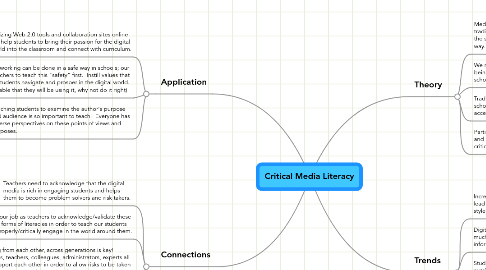Critical Media Literacy
por michelle kemp

1. Theory
1.1. Media Literacy is not about replacing traditional literacy; but adding and enhancing the skills taught in a creative and engaging way.
1.2. We must acknowledge that our students are being consumed by digital media outside of school.
1.3. Traditional literacies can be inhibitors in schools, limiting students passion and accessibility to different points of views.
1.4. Participatory Culture allows varying creative and intellectual powers to analyze and think critically about one story or content area.
2. Application
2.1. Utilizing Web 2.0 tools and collaboration sites online will help students to bring their passion for the digital world into the classroom and connect with curriculum.
2.2. Social networking can be done in a safe way in schools; our job as teachers to teach this "safety" first. Instill values that will help students navigate and prosper in the digital world. (its inevitable that they will be using it, why not do it right)
2.3. Teaching students to examine the author's purpose and audience is so important to teach! Everyone has diverse perspectives on these points of views and purposes.
2.3.1. Need to actively discuss these critical questions when using media in schools.
3. Trends
3.1. Increasing digital media outside of school has lead students to become accustomed to this style of literacy.
3.2. Digital Media access has been limited in schools, too much filters/blocks causes students to have information and engaging tools taken away from them.
3.3. Students who have limited access to digital media/literacies outside of school and in school are left "doubly behind" and the lack in these critical media skills excludes them from being active participants in today's culture.
3.4. When teachers say that media/digital literacy that students use outside of school has no connection/relationship with curriculum/literacies in schools we are de-valueing the styles in which they learn and collaborate best!
4. Connections
4.1. Teachers need to acknowledge that the digital media is rich in engaging students and helps them to become problem solvers and risk takers.
4.2. It is our job as teachers to acknowledge/validate these new forms of literacies in order to teach our students to properly/critically engage in the world around them.
4.3. Learning from each other, across generations is key! Students, teachers, colleagues, administrators, experts all must support each other in order to allow risks to be taken and learning to take place within this new digital, media literacy.
4.4. The multiple points of view within our history and content areas are extremely important. Engaging in the digital media world allows students to have access to and critically examine these various points of view. This will help them to become active members in our democratic society.


